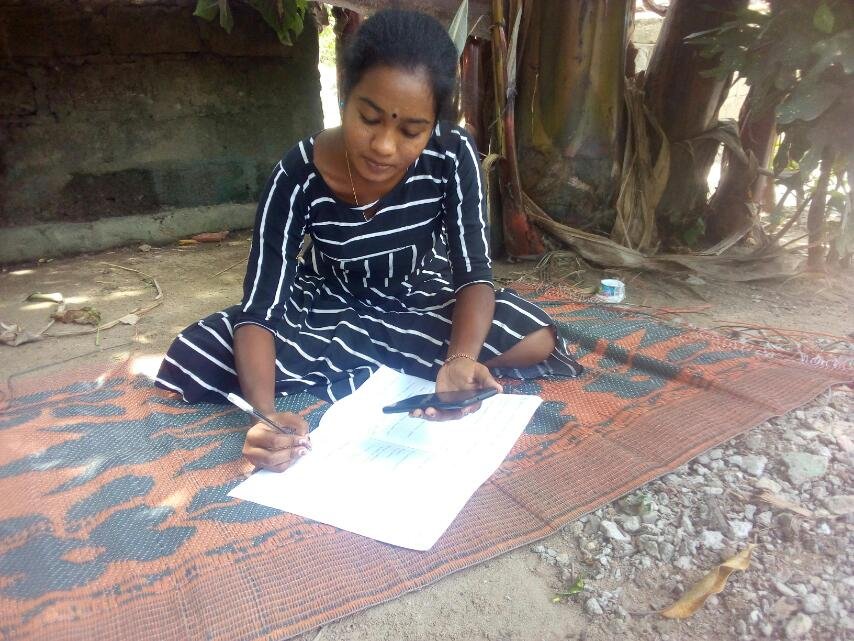Perunilan
People focus on education in modern times more than they did in the past. The reason is that education largely contributes to uplift the status of an individual in terms of social status. Sri Lanka provides free and equal access to education for all.
But, have the seeds of inequality been planted in the education system due to the pandemic?
Right now, signs of this inequality can be seen in school education in Sri Lanka. Free education helped develop an equal society with values to a certain extent, but the coronavirus pandemic disrupted its development.
Nobody expected the school holidays to first start on 12th March 2020 in fear that the pandemic would extend this long. Food, clothes, and shelter have once again become basic wants. However, anthropologists worldwide have accepted education as a basic need in the 21st century. The pandemic re-assures us of the value of education.
Students learning in Sri Lankan schools are bound to each other in matters like age and education. But growth is unavoidable, and catching up on missed education is a problem faced by all communities.
Education is both received and given collectively, targeting a set of students systematically. Different provisions are implemented worldwide to provide equal opportunities within diverse economic backgrounds.
Types of Schools
Sri Lankan schools can be categorised informally as follows:
- Schools without enough resources to provide education; 30%
- Schools under development in terms of resources to provide education; 40%
- Schools with enough resources to provide education; 25%
- Self-sufficient schools with an excess of resources; 5%
Type one schools are schools situated in areas with minimal resources, economy, transportation, and frail communication facilities.
Here, resources mean physical resources such as parents’ academic backgrounds and their role in the school community for instance. Due to coronavirus, the academic environment has transformed into an education system that depends highly on parents’ involvement. This factor has created huge differences in terms of educational productivity. It is a complicated process to balance it, integrate the system, maintain quality, and evaluate.
Equal opportunities in education depend on how society encourages education. Here, even though physical resources are developed in schools, the preparation of parents and students for education, training, and knowledge is at a superficial level.
Schools of the following type are the ones that have sustained resources to prepare students’ education through the active participation of parents and teachers. The education of 15% of students depends on the cooperation of their parents.
The next type of school is the one with all the facilities provided by the parents. 60% of students in these schools achieve success in education.
The other type of schools has ample facilities and prosperous parents as well. These schools have students and their parents who can spend on the education needs of students, including facilities for examinations.

Challenges to School Education
Sending children to school was a massive challenge even though schools were open from time to time amidst the pandemic. No one has the mentality to send their children to school in this kind of severe pandemic environment.
However, the decisions to continue education have created problems in schools around the country. Therefore, it is necessary to make policies considering school categorisations.
The primary responsibility of the children’s education has shifted from the teachers to the parents in the present situation. Accordingly, children of parents who have no such skills have fallen behind.
Primary students are worst affected by the situation. Online education is not a suitable environment for their academic activities. The personal touch of the teacher and learning in a school surrounding is vital. Early childhood is a crucial period of mental development of a child. Learning with peers, learning with unity, appreciation of the environment, guidance, physical activities, and learning with nature is essential for their age. It is not easy to gain education this way in the present context. It has been a big challenge to concentrate their body and the mind on online education through technology.
According to UNESCO, educational objectives for modern humankind are gaining knowledge, being active, living, and getting used to coexisting with others. Therefore, we need to make sure that ‘learn to live’ does not end up in a dilemma in this context. The pandemic must be controlled entirely for successful school education. Meanwhile, taking education to students under the present context has been a challenge for all schools. This can be done only through technology. At the same time, general government examinations are held to combine education and time. Therefore, technology plays a significant role for students who participate in those examinations. Are there social provisions for every student to achieve this facility? Using allocated funds, organising a proper education system is essential in this backdrop.

Education in Kilinochchi
The whole Kilinochchi district with a vast landmass is one educational zone. The majority of the 104 schools in the district are far from the main city, where transportation is challenging. There are approximately 10 urban schools. In this background, 50% of the primary teachers teach their students with the ‘Viber’ application. The percentage of participants in rural areas is 20%, while it is 75% in urban areas. Many children do not have the facilities to print out the assignments sent by teachers. Even getting access to the exercises has also been a challenge for many children. Most of them do not even have access to telephone facilities. In discussion with grade 11 students in one school, it was detected that only 25% of the students had those facilities. In this situation, it seems that some parents cannot afford to provide those facilities to children. Some of them face difficulties even when acquiring mobile data.
Even though primary teachers tried to introduce worksheets to students, considering these difficulties, they could not be appropriately delivered, and ultimately, they were piled up gathering dust. Health guidelines also do not permit distributing worksheets and collecting completed worksheets. Furthermore, as some areas were isolated, it was not practical to distribute worksheets.
About 20% of students were already struggling to catch up with their primary education even during non-pandemic times. Now, these students are even more vulnerable and drop out of schools due to their inability to catch up with online education.
Factors that need attention in the new learning environment
Four types of schools were mentioned earlier. Accordingly, in this context, to combine the teaching and learning processes, we have to consider the conditions mentioned below:
- Opportunity to connect to technology from the students’ villages.
- Parents’ trends towards technology
- Parents’ economic strength
- Tendency of children towards education
- Parents’ attitudes
- Number of students who obey their parents
- Tendency of the child to learn together with other children
- Child’s material resources and living environment.
- Mentality helpful for education
- Mental breakdown due to the narrowing of learning space: from large school’ spaces to small home
- Inability to learn together with other children
- Not having a physical place for education and inability to learn without a physical presence
- Collapse of the education levels due to lack of mediation of the teacher in knowledge sharing classrooms
- No longer having a classroom opportunities for talent and attitude expression
- Not developing study methodologies due to the lack of physical connection between the teacher and the student

The above factors help to monitor the effectiveness of the education provided through technology.
In classrooms, teachers guide students to the lesson either by punishment or through kindness, but they cannot do either in online classes because there is no way to record students’ feedback correctly. A teacher in a popular school in Colombo said that this alternative environment had given her only a 50% success rate.
In such a context, what can be the situation of the students in rural schools and small urban schools who have to go through many more obstacles?

It is unfair to hold standard examinations in such contexts with vast differences and discrimination.
Policies such as providing free textbooks, free shoes, free school uniforms, and free teachers are attempts by Sri Lanka to democratise education. To create an equal study environment, it is necessary to supply accessible internet facilities, necessary tools, and other support. As the students with economic and other facilities can create the study environment, the students without any facilities suffer due to common examinations. If the study environment is not monitored systematically, the inequality among social layers will be aggravated further.
සමානාත්මතාවයේ සිට අසමානතාව කරා ගමන් කරන නව අධ්යාපන ක්රමවේදය !
சமத்துவக் கல்வியில் இருந்து அசமத்துவத்தை நோக்கிச் செல்லும் புதிய கல்விச் சூழல்!









